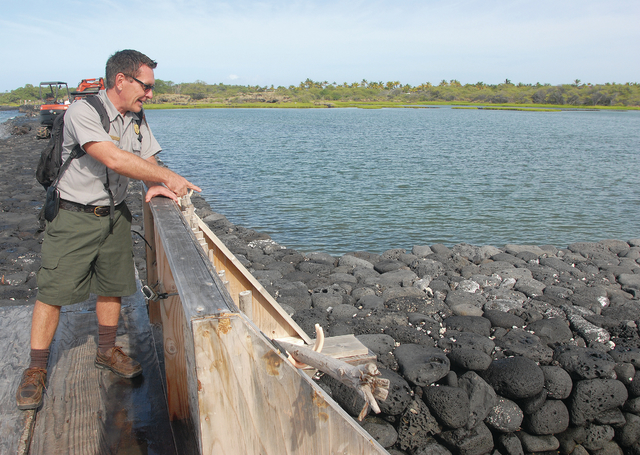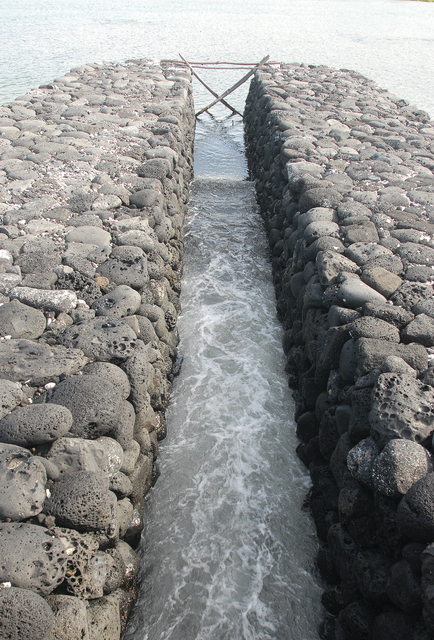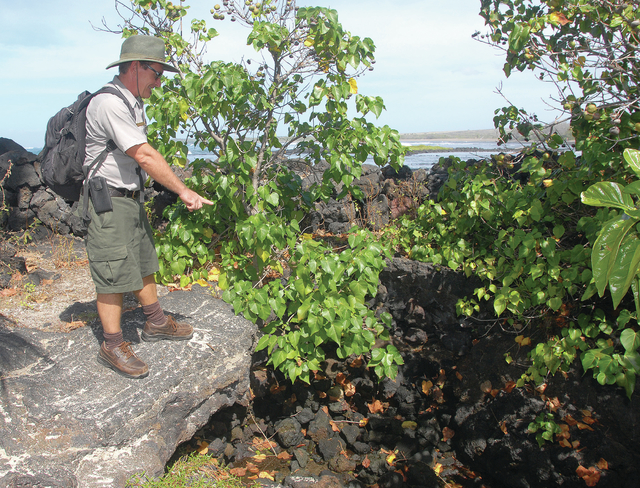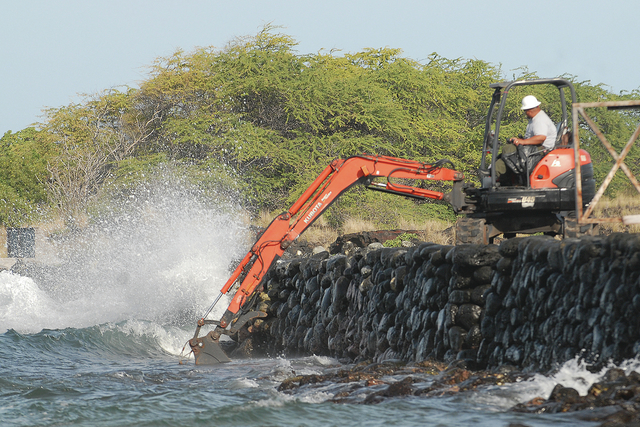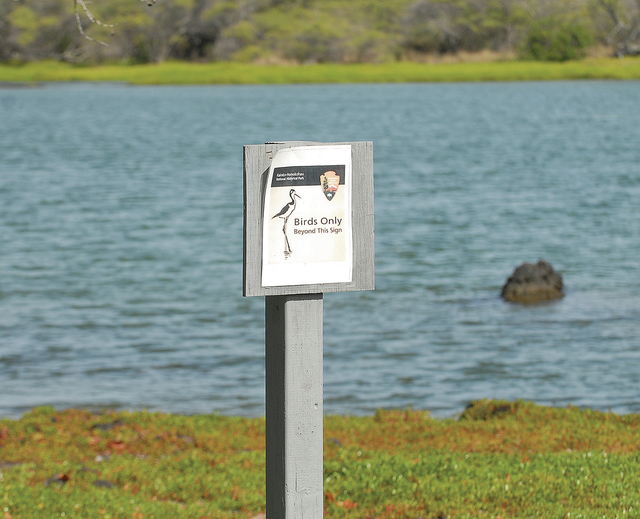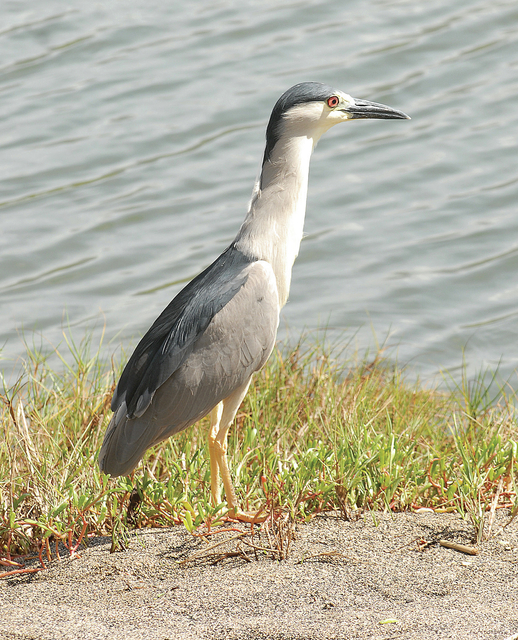HONOKOHAU — Centuries ago, those who lived here knew how special this place was.
It’s here, at what is now Kaloko-Honokohau National Historical Park, that the water flows beneath the ground and out to the bay, mixing with the saltwater to create an environment perfect for the ‘ama‘ama, or mullet, whose predators can’t tolerate the lower salinity.
The ancient Hawaiians knew this, and they took advantage of the fish’s movements by constructing a massive wall to create the Kaloko Fishpond.
By using channels and gates in the wall that controlled the fish’s entrances and exits, they were able to create a sustainable source of food for themselves.
Today, the mullet, awa and papio still swim back and forth through the channels built into the ancient wall, currently being reconstructed by park masons.
Nearby, seemingly lifeless anchialine pools teem with opae ula, the tiny red shrimp that make their homes in the brackish pools.
But park rangers here fear that increased use of the island’s limited freshwater resources at current and proposed wells, combined with decreased rainfall and rising sea levels, could upset the delicate ecosystem that relies on the balance of fresh and salt water.
As a result, they’re asking the state Commission on Water Resource Management to step in and designate the Keauhou Aquifer, which covers a vast region from Makalawena Beach to north of Kealakekua Bay, a water management area.
Designation would give the Park Service a chance to weigh in on the future of water withdrawals in the area.
That would include for any applications by developers to build new wells mauka of the park’s boundary. By having a chance to challenge permits, park staff could officially voice their concerns about potential impacts those wells could have on the park’s ecosystems.
Not everyone is on board with the proposal though.
Opponents to designating the aquifer say the National Park Service hasn’t shown any evidence that there’s a problem. Commission staff have already filed a report recommending against the designation, instead offering several alternative recommendations.
A hearing on the proposal is scheduled for 9:30 a.m. Tuesday at the West Hawaii Civic Center.
Thriving in fresh and salt water
Numerous species that make the park their home depend on salt water from the bay and fresh water from the Keauhou Aquifer, said Jeff Zimpfer, an environmental protection specialist at Kaloko-Honokohau.
That includes the mullet, whose young are more tolerant of fresh water than other species that would prey on them.
“So these mullet can go into the fresh water and hide from their predators,” he said. “Without the fresh water, we wouldn’t have more baby mullet to keep the mullet population going.”
The wall that separates the fishpond from the bay was built with channels in which Native Hawaiians could place a slotted gate that allowed small mullet to enter the pond and reach the fresh water without letting large mullet escape back to the bay.
“Without fresh water, we wouldn’t have the ability to manage the fishpond the way ancient Hawaiians did and have the species ancient Hawaiians did,” Zimpfer said.
The park is also home to two endangered species of water bird — the Hawaiian coot and the Hawaiian stilt.
The adult species of the birds are able to tolerate a wide range of fresh and salt water, given their ability to find food among salt water and fly to find fresh water.
But the young, who aren’t yet able to fly, need a local source of fresh water.
“We want to be able to have the whole lifecycle of the bird and not just the adults,” he said. “So we need fresh water so we can have new coots and stilts coming along.”
Well development
When the park was first created in 1962, there were very few wells in the area, Zimpfer said. But Kona’s development has led to the installation of more and more wells.
In September 2013, out of concern about the wells’ impact on the park ecosystem, the National Park Service asked the state’s Commission on Water Resource Management to make the Keauhou Aquifer a water management area — the request that’s still ongoing now.
State law allows the commission to designate a water management area when it finds that water resources are threatened by existing or proposed wells and other diversions of ground and surface waters.
Before a water system can be designated a state management area though, the commission needs to consider several factors.
That includes, among other things, whether increased water use could cause the rate of water withdrawal to reach 90 percent of the area’s sustainable yield — the maximum rate at which water can be withdrawn from its source without reducing quality.
The Keauhou Aquifer’s sustainable yield has been determined to be about 38 million gallons per day. Current water use in the Keauhou Aquifer system is about 14.55 million gallons per day, roughly 38 percent of the sustainable yield, according to the Park Service.
Opponents of the proposal to designate the aquifer a water management area say that’s not nearly high enough to justify the Park Service’s request.
“Nobody has provided any scientific information that says there is a problem,” said Peter Young, a former Department of Land and Natural Resources director and former chairman of the Commission on Water Resource Management, who is against the park’s proposal.
While Zimpfer acknowledges that the pump rate isn’t hitting the 90 percent threshold that would trigger designation, he said the sustainable yield model isn’t a perfect one.
“Part of the issue with the model is you assume that wells are evenly placed throughout the aquifer,” he said. “Well, wells aren’t evenly dispersed across the aquifer. They’re kinda clumped around the park and they want to put more around the park.”
Without wells being evenly distributed, there’s a disproportionate effect on parts of the aquifer, Zimpfer explained.
The aquifer, he said, isn’t a tidy volume of water, where withdrawing water from one end causes the whole volume of water to drop uniformly.
“This isn’t like that,” he said. “You’re gonna have areas around the well and down the hill from the well where they’re gonna get saltier than the rest of the aquifer. There’s pockets.”
“It’s not a bath tub,” he added. “It’s cracks and lava tubes and rocks and that kind of stuff; it’s not gonna be evenly distributed.”
The agency also said that saltwater intrusion at the Kahalu’u Shaft and related wells, located about seven miles south of the park, led to the development of new wells at higher elevations near the park.
“All seven of the higher-elevation wells operated by the (Department of Water Supply) … are located closer to Kaloko-Honokohau than the Kahalu’u wellfield,” wrote the Park Service in their petition for designation.
That resulted in more groundwater being withdrawn from the four ahupuaa in which the park is situated.
The park said those wells threaten park resources because groundwater removal mauka from the park “will have a greater effect on fresh water discharge to coastal ecosystems within the park,” stated the petition.
A Commission on Water Resource Management staff report prepared in advance of Tuesday’s meeting though rejected that argument, saying data shows no increase in measurements that reflect salinity at park observation wells.
Zimpfer also provided a chart that compared water withdrawals within the four ahupuaa of concern — namely Kohanaiki, Kaloko, Honokohau and Kealakehe – to withdrawals in the rest of the aquifer.
By scaling the sustainable yield down to the size of the four ahupuaa and looking at the pump rates of the existing wells in that area, they determined those wells are pumping at closer to 80 percent of the scaled-down sustainable yield.
Zimpfer said the Park Service asked to just designate the four ahupuaa, but the commission denied that request.
Young, though, said it’s crucial to keep in mind the different impacts of basal wells, those that are closer to sea level, and high-level ones.
He said the wells up mauka are very different from wells closer to the coast, and the high-level wells don’t have the same connection to the ocean that a well at the basal level would.
Those high-level wells, he added, are the main water sources for North Kona.
Need, timing questioned
If the commission designates the aquifer a water management area, anybody wanting to withdraw or divert use would need to get a permit to do so from the commission, according to the Water Code. Permits wouldn’t be required for domestic consumption by individual users, nor would one be required for a catchment system.
Existing uses would be able to continue until the commission acts on operators’ permits.
The Commission on Water Resource Management has currently designated 10 water management areas in the state.
They include five of six areas on Oahu, all four areas on Molokai and the Iao system on Maui.
Young said designating the Keauhou Aquifer as a state management area could put a bottleneck on development.
When the commission designates a management area, all existing permit holders would need to re-apply, he said.
All of those permits are subjected to a contested hearing.
“I would expect (the Park Service) would intervene with each application,” Young said.
Furthermore, the commission would need to resolve all of those permits before it considers any new ones.
Young said 10 years after the Iao Aquifer on Maui became a state management area, there are still some permits from before the designation that have yet to be approved.
“It’s not just a simple type of thing,” Young said.
Young said he isn’t opposed to the state designating aquifers when it’s appropriate. But, he said, the move needs to be supported by evidence.
“If there was a problem, I would be forefront in saying, ‘Hey guys, there’s a problem,’” Young said.
Young was the commission’s chairman when they designated Maui’s Iao Aquifer a water management area.
The state in 2003 designated the Iao Aquifer a groundwater management area after a 12-month running average of withdrawals exceeded 18 million gallons per day, according to an article published by the Honolulu Advertiser.
That aquifer’s sustainable yield was reported as being 20 million gallons per day.
That sort of thing isn’t happening at the Keauhou Aquifer though, Young said, so now isn’t the time for the state to step in.
The National Park Service petition though urges a proactive approach, saying the county’s projections for water demand don’t take into account what’s necessary for the protection of “traditional and customary Native Hawaiian rights and practices,” or the park ecosystem and species that rely on fresh water.
As a result, the petition said, delaying management until water use hits the 90 percent threshold “promotes an imprudent ‘crisis-oriented’ approach to water management.”
Staff report against petition
The commission staff who prepared a report in advance of Tuesday’s hearing also recommends against the designation.
“In the staff’s opinion, none of the eight criteria analyzed meet the designation criteria as specified in the Water Code and its rules,” states the report.
Instead the report suggests several other actions, including continued monitoring of water use, with care given to the area around the park.
There’s also a suggestion to refer applications for well permits to the Aha Moku system, a non-regulatory process focused on resource management. If a proposed well has the potential to impact traditional and customary practices, the staff report said, special conditions could be proposed to mitigate the well’s impacts. Disagreements about those conditions could then be referred to the commission.
Another idea is to encourage the construction of monitoring wells by anyone wanting to put a private well within the four ahupuaa where the park is situated.
Young said denying the designation doesn’t mean the question of water usage is a non-issue.
“When the commission denies it, it doesn’t mean everyone’s going to go home and not care,” Young said. “Everyone’s going to care.”
What should happen, he said, is that stakeholders continue to watch the issue, track changes and share findings in the event circumstances change.
“If it changes,” he said, “they’re going to be stepping forward and saying, ‘OK, now’s the time.’”
Commission staff made that same point in their report.
Staff suggested continued monitoring of pump rates, water levels and chloride levels, an indicator of saltwater intrusion.
The report also suggested that if the authorized planned use of the aquifer exceeds 80 percent of the sustainable yield, which would mean a pump rate of 30.4 million gallons per day, the commission start up public information meetings.
The commission could also start up those meetings if alternative water sources or high-level sources fail to materialize in the southern part of the aquifer region or withdrawal rates in that region reach about 17.1 million gallons of water per day, equal to 45 percent of the aquifer’s sustainable yield.







